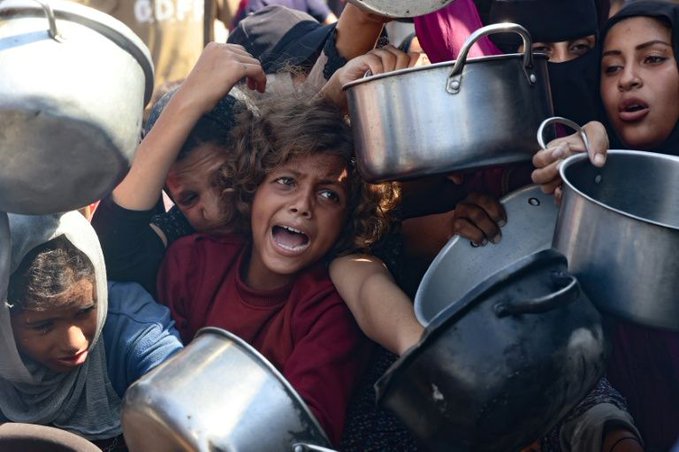The Gaza Strip is currently enduring one of the most severe humanitarian crises in recent history as a UN-backed Integrated Food Security Phase Classification (IPC) report officially declared famine in Gaza Governorate on August 15, 2025. This famine, unprecedented in the Middle East, is largely attributed to Israeli military actions and blockades that have dramatically restricted access to food, medical supplies, and essential services for Gaza’s more than two million residents.
Severity and Scope of the Famine
The IPC classification system defines Phase 5 as famine—characterized by widespread starvation, destitution, and deaths due to food deprivation. The report reveals that over 641,000 people (approximately 30% of Gaza’s population) currently face catastrophic conditions (IPC Phase 5). A further 1.14 million people (58%) are projected to be in Emergency (Phase 4), while another 396,000 people are in Crisis (Phase 3).
| Severity Level | IPC Phase | Number of People Affected | Percentage of Gaza Population |
|---|---|---|---|
| Famine (Catastrophe) | Phase 5 | 641,000 | 30% |
| Emergency | Phase 4 | 1,140,000 | 58% |
| Crisis | Phase 3 | 396,000 | 20% |
Source: Integrated Food Security Phase Classification (IPC), August 2025
Increasing Malnutrition and Vulnerable Populations
The famine’s impact on children and pregnant women is particularly alarming. Acute malnutrition is rapidly worsening, with estimates that by June 2026:
-
Over 132,000 children under five years will suffer from acute malnutrition.
-
Of these, over 41,000 children will experience severe acute malnutrition, a life-threatening condition.
-
Nearly 55,500 pregnant and breastfeeding women will require urgent nutritional support.
| At-Risk Groups | Number Affected | Comments |
|---|---|---|
| Children under 5 | 132,000 | Acutely malnourished |
| Children with severe malnutrition | 41,000 | High risk of mortality |
| Pregnant & breastfeeding women | 55,500 | Require urgent nutrition intervention |
Causes of the Famine: A Man-Made Catastrophe
Nearly two years of continuous conflict between Israel and Hamas-led Gaza have decimated Gaza’s infrastructure:
-
Over 70% of infrastructure has been destroyed.
-
Approximately 98% of Gaza’s cropland has been damaged or is inaccessible, destroying local food production.
-
The blockade restricts entry of food, fuel, medicine, and humanitarian aid.
-
Frequent military operations have destroyed bakeries, markets, and water treatment facilities.
-
Massive displacement has forced nearly 90% of Gaza’s population from their homes, further compounding food insecurity.
UN Secretary-General António Guterres described the famine as “a failure of humanity itself,” stressing that the occupying power, Israel, is legally obligated under international law to provide food and medical supplies to the civilian population.
Humanitarian Appeal and Response
UN humanitarian agencies including the FAO, WFP, UNICEF, and WHO have warned of the urgent need for:
-
An immediate ceasefire to allow safe delivery of humanitarian aid.
-
Unhindered access to food, water, medical supplies, and fuel.
-
Protection of civilians and critical infrastructure such as health and sanitation systems.
-
International support to scale up nutrition and emergency assistance programs.
Without large-scale and continuous intervention, the IPC warns the famine will expand beyond Gaza Governorate to other parts of the Strip by the end of September 2025, risking further lives.
Daily Reality: Starvation and Desperation
The crisis outside statistics reveals a dire living condition for many Gazans:
-
One in three people report going days without food.
-
Prices of basic food items have skyrocketed, making purchase impossible for many.
-
Hospitals are overwhelmed with hunger-related illnesses.
-
Malnourished children are dying at an increasing rate.
-
Many adults are skipping meals to feed their children.
Summary Table: Key Impacts of the Gaza Famine (2025)
| Impact Area | Description |
|---|---|
| Population Affected | Over 2 million (entire Gaza population) |
| People in Famine (IPC 5) | 641,000 |
| People in Emergency (IPC 4) | 1.14 million |
| Acute malnutrition | 132,000 children, 55,500 pregnant women |
| Infrastructure damage | 70%+ destroyed |
| Cropland Damage | 98% damaged or inaccessible |
| Displacement | 90% displaced at least once |
| Daily Hunger | 39% go days without eating |
Conclusion
The UN-backed famine declaration for Gaza is a stark indicator of one of the gravest humanitarian crises today. It is unmistakably a man-made catastrophe linked directly to prolonged conflict and blockade policies that have strangled the availability of food and essential supplies. Humanitarian experts warn that the situation is deteriorating at an alarming pace and call for immediate international intervention, a ceasefire, and full humanitarian access to prevent further loss of life and suffering in Gaza.
This crisis challenges the global community’s commitment to international humanitarian law and human rights, demanding urgent and collective action not just to relieve hunger but to restore dignity and hope for the people of Gaza.

